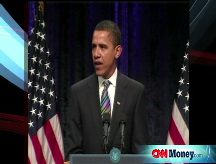Bonds rise on jobs report
Treasury prices climb as the government reports that the economy lost 2.6 million jobs in 2008.
NEW YORK (CNNMoney.com) -- Government debt prices rose Friday after the Labor Department released a dismal December unemployment report.
Treasurys seesawed earlier in the session as investors digested the jobs data, but a selloff in the stock market helped boost demand for bonds in the afternoon.
The Department of Labor reported that the economy lost 524,000 jobs in December, bringing 2008's total job losses to 2.6 million - the worst total since 1945. Economists surveyed by Briefing.com had forecast a loss of 525,000 jobs in December.
The unemployment rate rose to 7.2% last month from 6.7% in November and was higher than economists' forecasts of 7%.
"The message of the report is really of profound weakness," said Pierre Ellis, senior economist at Decision Economics.
A report released earlier in the week by payroll processor ADP said that the private sector shed 693,000 jobs in December, and while the government's report was not as terrible, Ellis said it was very negative for the economy.
Government bonds are considered the safest place for investors to keep their funds. When negative economic news comes out, Treasury prices tend to rise as investors park their money the safe-haven.
Meanwhile, with the government deficit already in excess of a trillion dollars and President-elect Barack Obama pushing for a massive stimulus package, the volume of government debt coming to market in the coming months is putting downward pressure on government bond prices.
Obama's plan is focused on infrastructure spending as a way of creating new jobs. He has also pitched tax cuts as part of his plan. The combination of increased spending and tax cuts may prop up the staggering economy, but the plan will also put Uncle Sam deeper in debt as more and more securities are sold.
"The market is looking two steps ahead, and unfortunately the link seems to be greater economic weakness, means more stimulus, means more bonds," said Ellis.
"There is almost this relationship between how weak the economy is and how many more securities are going to be coming," Ellis added. "The market is almost choking on the looming supply of Treasurys."
Government debt prices: The price on the benchmark 10-year note rose 16/32 to 111 28/32, and its yield was 2.39%. Bond prices and yields move in opposite directions.
The 30-year bond rose 1/32 to 128 2/32, and its yield was 3.058%.
The two-year note edged up 5/32 to 100 7/32, and its yield was 0.75%.
The yield on the 3-month note dipped to 0.07% from 0.08% Thursday. The 3-month note is considered a gauge of investor confidence because investors move funds into and out of the short-term note as they assess risk in other places of the marketplace.
Lending rates: Meanwhile, bank-to-bank lending rates continued to work lower. As the credit crisis peaked in the middle of the fall, bank-to-bank lending rates spiked because banks were more interested in hoarding cash.
However, a slew of unprecedented efforts by central banks around the world aimed at making lending cheaper - and thus more readily available - have worked to bring lending rates down. For example, the Bank of England cut its key lending rate to 1.5% from 2% Thursday.
The 3-month Libor rate fell to 1.26% from 1.35% Thursday, according to data available at Bloomberg.com. The last time that lending rate was at such levels was May 2004. Meanwhile, the overnight Libor rate held steady from Thursday at 0.10%, which was an all-time low.
Libor - the London Interbank Offered Rate - is a daily average of rates 16 different banks charge each other to lend money in London, and it is used to calculate adjustable-rate mortgages. More than $350 million in assets are tied to Libor.
Two market gauges showed increasing confidence in the credit markets.
The "TED spread," narrowed to 1.19 percentage points from 1.27 percentage points late Thursday. The higher the spread, the less willing investors are to take risks. The rate widened to historic levels as as the credit market froze in the fall. As governments around the world have eased lending rates and worked to increase liquidity in the marketplace, the spread has come back down.
Another indicator, the Libor-OIS spread narrowed to 1.08 percentage points from 1.16 percentage points. The Libor-OIS spread is a measure of how much cash is available for lending between banks. It's used for determining lending rates. The bigger the spread, the less cash is available for lending. ![]()





